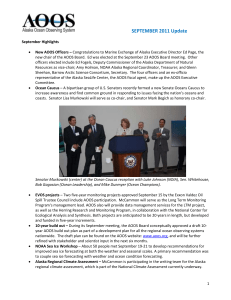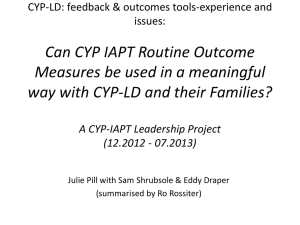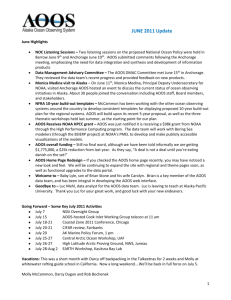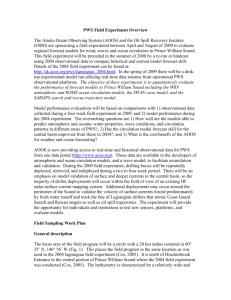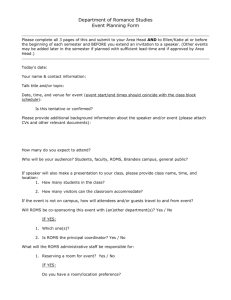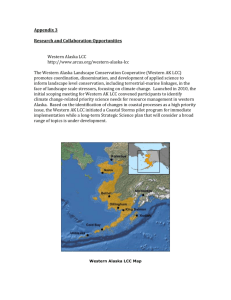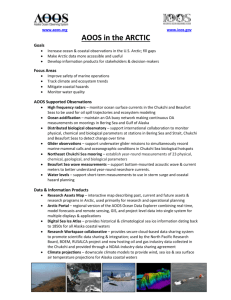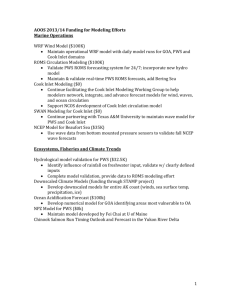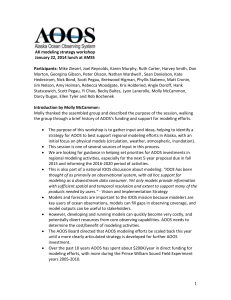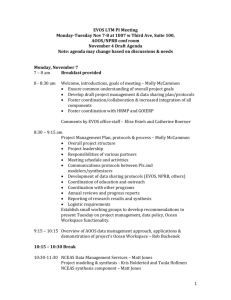Alaska`s marine resources are inherently diverse along
advertisement
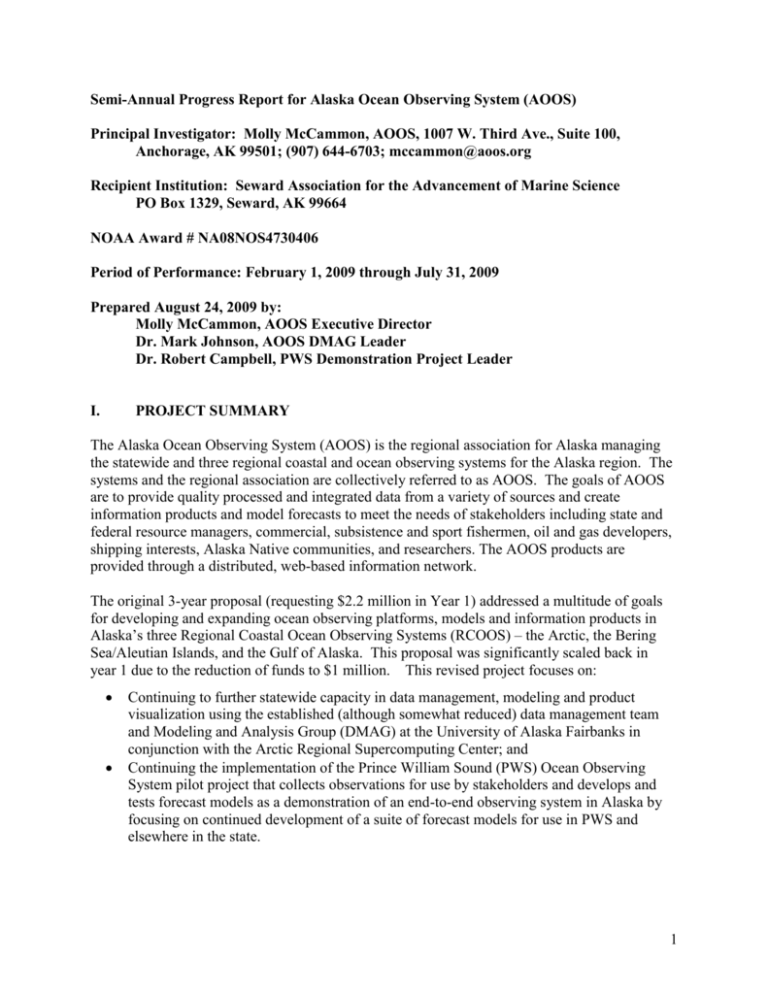
Semi-Annual Progress Report for Alaska Ocean Observing System (AOOS) Principal Investigator: Molly McCammon, AOOS, 1007 W. Third Ave., Suite 100, Anchorage, AK 99501; (907) 644-6703; mccammon@aoos.org Recipient Institution: Seward Association for the Advancement of Marine Science PO Box 1329, Seward, AK 99664 NOAA Award # NA08NOS4730406 Period of Performance: February 1, 2009 through July 31, 2009 Prepared August 24, 2009 by: Molly McCammon, AOOS Executive Director Dr. Mark Johnson, AOOS DMAG Leader Dr. Robert Campbell, PWS Demonstration Project Leader I. PROJECT SUMMARY The Alaska Ocean Observing System (AOOS) is the regional association for Alaska managing the statewide and three regional coastal and ocean observing systems for the Alaska region. The systems and the regional association are collectively referred to as AOOS. The goals of AOOS are to provide quality processed and integrated data from a variety of sources and create information products and model forecasts to meet the needs of stakeholders including state and federal resource managers, commercial, subsistence and sport fishermen, oil and gas developers, shipping interests, Alaska Native communities, and researchers. The AOOS products are provided through a distributed, web-based information network. The original 3-year proposal (requesting $2.2 million in Year 1) addressed a multitude of goals for developing and expanding ocean observing platforms, models and information products in Alaska’s three Regional Coastal Ocean Observing Systems (RCOOS) – the Arctic, the Bering Sea/Aleutian Islands, and the Gulf of Alaska. This proposal was significantly scaled back in year 1 due to the reduction of funds to $1 million. This revised project focuses on: Continuing to further statewide capacity in data management, modeling and product visualization using the established (although somewhat reduced) data management team and Modeling and Analysis Group (DMAG) at the University of Alaska Fairbanks in conjunction with the Arctic Regional Supercomputing Center; and Continuing the implementation of the Prince William Sound (PWS) Ocean Observing System pilot project that collects observations for use by stakeholders and develops and tests forecast models as a demonstration of an end-to-end observing system in Alaska by focusing on continued development of a suite of forecast models for use in PWS and elsewhere in the state. 1 II. PROGRESS AND ACCOMPLISHMENTS A. Data Management and Analysis Group: Dr. Mark Johnson, Lead PI (University of Alaska Fairbanks) The Data Management and Analysis Group develops data management and communications products, data visualization tools, and satellite remote sensing products. Data Management and Communications (DMAC) (UAF) Data Manager Rob Cermak continues to serve on the national DMAC committee. AOOS DMAC is collaborating with the Coast Guard Search and Rescue, the North Pacific Research Board, Minerals Management Service, Barrow Arctic Science Consortium and others to provide data to state and federal agencies and meet national IOOS goals. At present, we are compliant with all data delivery goals as stated by IOOS. With supplemental funding from the North Pacific Research Board, AOOS launched the Alaska Marine Information System, a project and metadata browser that that is an easy to use webinterface to search and discover Alaskan projects and associated datasets. AMIS is searchable by a suite of variables including the PI name, dataset title, start and end dates, funding organization, keywords, IOOS core variables, study area, science platform or sensor, and key words. Each project has a geographical study area so the user can see on a map where projects are located and how different project areas may overlap. Now that AMIS is functional, we are expanding the project database. More than 600 projects have been harvested from UAF, MMS, NPRB, NOAA, and NSF to be uploaded into the system. AMIS is being developed as a direct result of stakeholder requests from NPRB, MMS and researchers with whom AOOS has been meeting. AOOS is revising the design of the DMAC web pages to streamline them and make them easier to use. The new site is on-line and we are currently responding to community feedback. AOOS funding reductions leave us with requests that come in from across the state that outstrip the DMAC’s ability to meet these needs. To maintain critical mass, AOOS DMAC has acquired funding from the North Pacific Research Board to be the data management organization for the Bering Sea Integrated Ecosystem Research Program (BSIERP), and all data will ultimately meet IOOS standards. Data and Information Product Development (UAF) Our major effort during this time frame is data support for the Prince William Sound Field Experiment that occurred in late July 2009. Our main goal was to make available the data collected from the sound for assimilation into the ROMS model described elsewhere and to other investigators. ROMS PI Dr. Yi Chao has indicated that there were no operational problems with the AOOS DMAC data handling into the ROMS forecasts. Data from ten investigators were ingested and stored in the DMAC archives at UAF after it was sent from the field. A number of platforms produced data in real time (HF radar, several moorings, SnoTel stations, buoys) and other platforms produced data that was transmitted each evening by the PI (CTD, AUV, glider, drifters, and model 2 data). Rob Cermak, DMAC data manager, was on conference calls twice daily with other investigators to handle data questions, respond to changes in data format from the PIs, and address any questions about data transfer and upload. The experiment provided data on temperature, salinity, surface currents, chlorophyll, sea level, tides, winds, waves, model forecasts, wind forecasts, satellite imagery, snow pack thickness, 3D temperature and salinity from a glider and an AUV, and other data acquired during the experiment. DMAC provided a web site to locate data by investigator and platform. To help the PIs communicate in the field, a PI blog was set up by DMAC for access by the field experimenters. The blog was used by many of the PIs to share information on experiment design, provide graphics, or change the experiment design. The field portion of the experiment was completed on 3 August, and our current goal is providing an easy to use interface for PIs to acquire and download all experiment data. DMAC also responds to meet the national IOOS needs. Data Manager Rob Cermak serves on the national DMAC committee, participates regularly on IOOS conference calls, and works to align AOOS DMAC tasks with the national goals. B. Prince William Sound Demonstration Project: Dr. Robert Campbell, Lead PI, Prince William Sound Science Center; Co-PI Dr. Carl Schoch, consultant) The PWS pilot project is progressing as planned. Funds in this proposal are being used to complete the 4 major AOOS models, conduct the observing system experiment (OSE) July 19 to August 3, 2009, and conduct the model assessment from the resulting dataset. An update of the respective efforts is detailed below. Regional Oceanographic Modeling System (ROMS) modeling (Dr. Yi Chao, Jet Propulsion Laboratory) All work during this period focused on preparing and participating in the real-time field experiment during July 21- August 3, 2009. A data-assimilating 3-level nested ROMS configuration was used with a 1-km resolution domain covering Prince William Sound. Nearly all the data gathered during the experiment were assimilated in real-time, including: HF radar surface currents, Ship CTD temperature and salinity profiles, glider and REMUS AUV profiles, and AVHRR and MODIS sea surface sea temperatures. ROMS nowcasts and forecasts were produced and images, analysis and model output provided to the field experiment community via the JPL and AOOS experiment web sites beginning in early July. In addition, during the two weeks of the field experiment, a daily forecasting summary was provided which provided a synopsis of atmospheric and oceanic conditions in the Prince William Sound and a discussion of any changes forecast for the subsequent 24 to 48 hours. Most results can be found at the JPL OurOcean/PWS portal (http://ourocean.jpl.nasa.gov/PWS); a preliminary assessment of the ROMS performance during the experiment is given here. During the field experiment, JPL developed a daily summary map showing the location of the most recent observational platforms. Figure 1 shows the locations of all the observational platforms during the 2-week period. JPL also developed an interactive wind page showing the hourly wind map provided by the WRF model (Figure 2a). Hourly wind speed and direction predicted by WRF can be directed compared against the buoy observations (Figure 2b). 3 With the observational data being assimilated into ROMS, the PWS circulation and variability were realistically forecasted during the field experiment. During the first week of the field experiment, the central sound was dominated by the easterly winds and northward surface current (Figure 3a). The wind weakened during the second week of the field experiment, with the central sound circulation characterized by a cyclonic eddy (Figure 3b), which is very similar to observations made during the 2004 field experiment. Associated with the Hinchinbrook Entrance, inflow of relatively high surface salinity waters (greater than 30 PSU) were advected into the central Sound. Figure 4 shows the surface salinity distribution as forecast by ROMS for July 25, 00 GMT. It shows a relatively narrow north-south tongue of high salinity in the central Sound. The purple line in this image shows the track of the Cal Poly glider through this region during approximately the same time. Figure 5 compares this ROMS forecast salinity to that observed by the glider. It shows salinities in a longitude-depth cross-section. Near the surface, both observations and the ROMS forecast show salinities increasing from east to west, with the glider observations showing particularly strong gradients near 213.2E, implying that the tongue of high salinity is sharper than that seen in the ROMS forecast. Although the ROMS gradients were weaker than observed by the glider (in the vertical as well as the horizontal) the overall pattern is reproduced quite well. The positive impact of the ship CTD data on the ROMS nowcast is shown in Figure 6. The temperature impact is relatively larger than the salinity, mostly due to the larger error in estimating the fresh-water input into the PWS. A web-based interactive drifter trajectory tool was developed shortly before the field experiment. Users can release simulated drifters using the most updated ROMS hourly forecast. Toward the end of the field experiment, an ensemble ROMS forecast was also developed using slightly different initial conditions. Figure 7 shows a set of simulated drifter trajectories using about a dozen ensemble ROMS forecasts that can be directly compared against the observed drifter trajectory. 4 Figure 1. Locations of the in situ observational sensors and platforms during the 2-week long 2009 field experiment. Figure 2a. A typical (2:00 GMT July 27, 2009) weather map being updated hourly during the 2009 field experiment showing the surface wind being predicted by the WRF model (black arrow and color contours) and measured by the ocean buoys (red arrow). 5 Figure 2b. Time series of the wind speed (top) and direction (bottom) during the 2-week field experiment as measured (red circles and line) and predicted by WRF (blue square is nowcast and blue line is hourly forecast) at the NDBC buoy 46069 location in the central sound. Figure 3a. Surface current map as measured by the HF radar (red arrow) and predicted by the 3D ROMS circulation model (black arrow) during the first week of the field experiment (July 18 – 21). 6 Figure 3b. Surface current map as measured by the HF radar (red arrow) and predicted by the 3D ROMS circulation model (black arrow) during the second week of the field experiment (July 31 – Aug 3). Figure 4. ROMS twenty-four hour forecast surface salinity (color, PSU) and surface current distribution for 25 July 2009, 00 GMT. The purple line represents the track taken by the Cal Poly glider at approximately the same time. 7 Figure 5. East-west section (along the line shown in Figure 4) of the temperature (left) and salinity distributions as a function of depth as measured by the Slocum Glider (top) and predicted by the 3D ROMS model (bottom) during August 24-25. Figure 6. Typical vertical profiles of temperature and salinity as measured by the ship CTD and predicted by ROMS on July 28. The error plots show the positive impact of assimilating this particular ship CTD data into ROMS. 8 Figure 7. Drifter trajectories as measured from the released time of July 25 at 02 GMT and recovered time of July 28 at 02 GMT (left panel) and predicted by a cluster of ensemble ROMS forecasts with slightly different initial conditions (right panel). Ecosystem modeling (Dr. Fei Chai, University of Maine) As a part of PWS operational modeling activity, nutrient-phytoplankton-zooplankton (NPZ) processes have been incorporated into the ROMS circulation model. Dr. Chai at the University of Maine has been collaborating with Dr. Yi Chao and his group at UCLA and JPL, and successfully implemented a NPZ model into the 3 level nested ROMS (Regional Ocean Model System), with 1 km resolution (level 2) for the Prince Williams Sound region. The NPZ model is based on the Carbon, Silicate, and Nitrogen Ecosystem model (CoSINE), which was developed for the equatorial Pacific and modified for the Gulf of Alaska and PWS. Dr. Chai has conducted several ROMS-CoSiNE model simulations, and preliminary analysis focused on the seasonal cycle of 2004. Some ROMS-CoSiNE results were presented at the PWS PI meeting in January 2009. During the past six months, efforts were focused on conducting the ROMS-CoSINE model simulations near real time, and producing the NPZ model results for the PWS field experiment during July 21- August 3, 2009. Dr. Chai’s team started running the ROMS-CoSINE model April 1, 2009, and saved the model output every 5 days. Starting 1 June 2009, the model results were outputted four times a day. During the first week of the field experiment, the weather was quite stormy with abundant rainfall, and good remotely sensed ocean color images were not available. On August 2, the weather was clear and there was a good MODIS image showing surface chlorophyll distribution. The modeled monthly (July) averaged chlorophyll was compared with the MODIS derived chlorophyll, (Figure 8). Due to the cloud coverage, which reduces the surface light level, for the weeks before August 2, how phytoplankton growth evolved is unknown, i.e., there is little information about temporal variation of chlorophyll. In general, the model is able to reproduce a similar level of chlorophyll values for PWS compared to the MODIS observations. Also, the modeled sea surface temperature (SST) compares very well with the AVHRR derived SST. In part, this is due to the fact that the ROMS assimilates the observed information, including both in situ and remote sensing products, which constrains the physical processes in the ROMS. Due to a lack of biological observations, biological information 9 was not assimilated into the model, making it difficult to compare biological model results with the observations for near real time conditions. A post hoc comparison however, is ongoing. As well as comparing the modeled results with the remote sensing observations, the ROMSCoSINE predictions were also compared with the in situ observations. Three moorings in PWS collect continuous records of temperature and chlorophyll: at Esther Island, Naked Island and Port San Juan (Figure 9). Due to some technical and communication issues, the mooring data was not included into the data stream until near the end of PWS field experiment, so a near real time model-data comparison was not possible. The ROMS-CoSINE modeled surface chlorophyll and SST were compared with the mooring observations at Esther Buoy (Figure 10), Naked Island (Figure 11), and Port San Juan (Figure 12). Overall, the ROMS reproduced the observed temperature quite well. For the chlorophyll comparisons, the ROMS-CoSINE was able to reproduce a similar order of chlorophyll level at all three locations, but the model could not capture the large temporal variation of chlorophyll at Naked Island and Port San Juan, especially during April and May. Model evaluation and comparisons with other types of observations is continuing. In collaboration with Dr. Rob Campbell at the PWS Science Center, nutrients, oxygen, and more chlorophyll observations will be compared with the modeled results, especially focusing on the sections where the field measurements were conducted. In the near future, based upon these model-data comparisons, the ROMS-CoSINE model will be re-run for the period from April to October 2009, which will include adjusting some parameter values to improve the model performance. The goal for the ROMS-CoSINE modeling work during the next year is to prepare a manuscript to document the model development and improvement with model-data comparisons for PWS. 10 Figure 8. Comparison between the modeled sea surface temperature (SST) and chlorophyll (lower panels) and the satellite observed SST (AVHRR) and chlorophyll (MODIS) (top panels). The August 2, 2009 has a rarely clear day image for more than one month, so the monthly averaged model results for July 2009 were used. Figure 9. Bathymetry of Level-2 nested ROMS model and sample stations in the model (Esther Buoy, Naked Island, and Port San Juan). AMBCS (http://www.ambcs.org) has maintained a continuous buoy observation in these three locations since April 7, 2009. 11 Figure 10. Comparison of SST and chlorophyll between in situ data and model output at Esther Buoy. For observed chlorophyll, only those data measured around mid-night are used and plotted. For the model results in April and May, the model output is every five days. Starting June 1, 2009 the model output is saved four times every day. 12 Figure 11. Comparison of SST and chlorophyll between in situ data and model output at Naked Island. For observed chlorophyll, only those data measured around midnight are used and plotted. For the model results in April and May, the model output is every five days. Starting June 1, 2009 the model output is saved four times every day. 13 Figure 12. Comparison of SST and chlorophyll between in situ data and model output at Port San Juan. For observed chlorophyll, only those data measured around midnight are used and plotted. For the model results in April and May, the model output is every five days. Starting June 1, 2009 the model output is saved four times every day. Observing System Experiment (Mark Halverson, Prince William Sound Science Center) The field portion of the Sound Predictions 2009 demonstration project has just concluded. The Prince William Sound Science Center commitment consisted of field measurements including CTD surveys, underway thermosalinograph surveys, and drifting buoys. Current work is centered on post-processing the data and interpreting the results in preparation for reports and publications. Two such examples of future papers and presentations include a presentation by Mark Halverson at the 2009 Eastern Pacific Ocean Conference, and plans to collaborate with Carter Ohlmann (UC Santa Barbara) and other PIs on preparing a publication of the drifter tracks. Seasonal help was used for the field experiment, including an undergraduate physics major, to assist with field operations and post-cruise data analysis. Preliminary hydrographic results suggest that the main circulation in central PWS resembles an anti-cyclonic gyre. A salinity transect along the north-to-south (“NS”) line on August 1, 2009 14 (Figure 13) exhibits domed isohalines – characteristic of anti-cyclonic gyre circulation. The influence of fresh water runoff on surface water is apparent at both the northern and southern stations. As an example of the drifter results, the trajectory taken by an Argosphere is shown in Figure 14. Argospheres are only partially submerged, implying their trajectory represents some combination of water movement and wind. The track in Figure 14, as well as the tracks from other drifters drogued relatively close to the surface, underscores the role of wind in modifying both the tidal motion and the gyre circulation. The entrance moorings were most recently recovered in October 2008. The instruments and hardware were serviced between February and mid-March 2009, and redeployed at the end of March. Their recovery, and subsequent redeployment, is slated for October 2009. A particularly exciting aspect of the forthcoming deployment is the use of a recently refurbished low drag buoy in Hinchinbrook Entrance. Finally, analysis on the latest mooring period will begin in fall 2009. Figure 13. Salinity contour of a NS transect for 1 August 2009. Doming of the isohalines near the center of the transect is apparent, and indicates an anti-cyclonic gyre. 15 Figure 14. Trajectory of a single surface float over a period of 30 hours. The average speed of the drifter during this deployment was 90 cm/s. This deployment coincides with a period of strong southeasterly winds. Nearshore moorings (Dr. Robert Campbell, PI) Three nearshore moorings were deployed April 7th 2009 on floats located in Port San Juan, Naked Island, and Esther Island. Each mooring consists of a Seabird Electronics model 16 (measuring conductivity, temperature, and pressure), and a WETlabs FLNTUSB (chlorophyll fluorescence, turbidity). Measurements are taken every ten minutes. The Port San Juan and Esther Island instruments are interfaced through a Campbell Scientific CR1000 data logger, which transmits the data to a StarBand satellite base station at nearby salmon hatcheries. Data is sent out by internet, and archived on the Alaska Meteor Burst Communication System (ambcs.org), from which it is served into the AOOS data repository. There is no base station at Naked Island, and the instruments are set to log data internally. The Naked Island mooring was visited three times during the 2009 field experiment, and the data uploaded to the AOOS ftp site. The battery power in the Seabird instrument began to fail in midJuly, resulting in a lower sampling frequency; that was something of a surprise since the anticipated battery life was six months. The Esther Island mooring initially did not communicate with the base station; a promontory between the float and the base station prevented the line-ofsight required for the VHF modem. To facilitate communication, a permit was obtained from the Alaska Department of Natural Resources, and a repeater station was set up on the opposite side of the inlet on June 9, 2009. Following the installation of the repeater site, it was found that the 16 instrument did not always respond to the query made by the data logger. This has been remedied in software, but has resulted in gaps in the data record from that float. The temperature and salinity records (Figure 15) from all the floats show a similar pattern, with warming over the summer months and a concomitant reduction in salinity. There is some indication of a north-south gradient in warming, with Esther Island being the warmest and Port San Juan the coolest; all sites were approximately the same temperature by August. The Naked Island site had higher salinity, which is likely due to its location: its position in Cabin Bay is close to the open waters of PWS. The Esther Island and Port San Juan sites are in enclosed bays, and closer to shore. The timing of bloom events seen in the chlorophyll-a record was quite different between sites. There was a bloom at Naked Island in late April and late May, while the bloom at Port San Juan was in early and mid-May. Temperature (oC) 20 15 10 Port San Juan Naked I. Esther I. 5 0 40 Salinity 30 20 10 Chlorophyll-a (mg ml -1) 0 60 40 20 0 Apr May Jun Jul Aug Sep Figure 15. Temperature (top panel), salinity (middle panel) and chlorophyll-a (bottom panel) time series from the Port San Juan (blue), Naked Island (Green) and Esther Island (red) moorings. HF Radar (Dr. Mark Johnson, UAF) The HF radar will be operated in Prince William Sound at the Shelter and Knowles Bay sites for at least two weeks beginning July 15, 2009 using existing propane generators. 17 For the PWS Field experiment, HF radar was installed at the Shelter and Knowles Bay sites and started data transmission of HF radar showing 2D currents before the July 15, 2009 target date. This was several days ahead of the experiment proper, but was chosen to allow the ROMS model sufficient time to initialize and assimilate the data and spin up. Further, it allowed testing of DMAC data protocols ahead of the experiment. Since January 2009, all PIs were asked to provide example data sets ahead of the July experiment, and several did, helping to spread out DMAC tasks ahead of the field experiment. The major issue regarding the use of HF radar in Alaska is providing electricity and telecommunications at remote sites. There is the need for a robust, cost-effective remote power source to counter the extreme costs of using traditional power such as diesel generators. To meet the PWS FE program needs, a team of four UAF investigators arrived in the Sound and began installing power, telecommunications, and HF radar hardware on July 5th, completing the task in about ten days. Biodiesel generators, biodiesel fuel, battery banks, master power controllers, huts to shelter the electronics, satellite dishes, telecommunications hardware, HF radar chassis with proprietary software and hardware, and send and receive HF antennas were transported to the two sites, installed, and tested, and acquired data to map 2D surface currents late in the day on July 14th. The DC powered HF radar units are now seven years old, and the first designed by CODAR for DC power. Future HF radar operations in Alaska will need new units and up-to-date hardware and software. The radar team was able to keep the systems going with only a few temporary shutdowns. US Forest Service permits for use of the sites required that all equipment be removed at the end of the field experiment. The UAF HF radar group also transported and set up three HF radar sites in Cook Inlet Alaska during summer of 2009 to respond to the volcanic activity of Mt. Redoubt which sits above an oil storage terminal on Cook Inlet. The HF radar was installed and operated for about a month, including setup on an existing oil platform, the first time this was done in Alaska. Data were sent to NOAA HAZMAT and, also for the first time, 2D surface current data were used to drive the NOAA GNOME model that forecasts trajectories used in oil spill response. Expertise both from DMAC and HF radar personnel was needed, and separate funding for most of the field logistics was supplied by UAF and the Cook Inlet Regional Citizens Advisory Council. Despite data gaps and problems with old HF radar components, the UAF team has demonstrated the ability to install and operate HF radar at remote sites, although it is costly. The long-term HF operations in Alaska should recognize significant start-up costs associated with supplying power, establishing telecommunications, site preparation, and transfer of equipment to remote locations, as well as significant operational costs. III.ISSUES A. Funding uncertainty AOOS began operating in the summer of 2005 using a $2 million FY 2005 earmark. That earmark was reduced to $1.7 million in FY 2006. Following a competitive process, AOOS was awarded $750,000 in June 2007, and following another competitive process for FY 08 funds, an additional $1 million in summer 2008, followed by an additional $1 million in summer 2009. This funding variability and uncertainty continue to make it very difficult to develop and sustain 18 a program, hire and keep qualified personnel, and proceed forward with long-term plans. The reduction in 2007 required AOOS to drop its financial support for the Amukta Pass and Southeast mooring programs and the Barrow ice radar, reduce staffing for the DMAG group, and significantly pare down the goals for the Prince William Sound pilot project. These are significant losses to the AOOS stakeholders since they are in addition to the loss of the Bering Strait moorings and work in Cook Inlet/Kachemak Bay in 2006. With the recent record minimum Arctic ice in summer 2007, there is a pressing need for improved monitoring and forecasting capability in Alaska—the U.S. Arctic—for marine navigation and safety and to continue to understand climate change. Funding in 2008 will only allow for the core data management group to continue, and to fund the Prince William Sound demonstration project at a bare minimum level. We note this again: If the AOOS program is looking at approximately $2 million a year as its base funding for the near future (as opposed to ramping up from a $2 million minimum), the AOOS board likely would re-consider how we approach the issue of expanding observation capacity in the three AOOS regions. We will continue our existing efforts to leverage the AOOS data system with other agency programs that might have future funding for observation components, however, the geographic scale of Alaska makes development of operational observing systems extremely problematic. B. Future of HF Radar The use of HF radar technology is critical for the future of AOOS in Alaska. The major issue regarding the use of HF radar as a tool in Alaska’s ocean observing program relates to the lack of electricity at remote sites and the need for a robust, cost-effective remote power source. Major funding is required to develop and maintain a team to work on HF radar year round. Apparently this is an issue of concern to other Regional Associations, and thus, might be appropriately addressed at the national level. We are exploring how to tap into existing power infrastructure in Prince William Sound because the HF radar there (as elsewhere) is critical for data assimilation into models. This continues to be a critical issue for AOOS. C. Modeling needs The ocean circulation models being developed for Alaska waters depend on the boundary conditions identified through large-scale North Pacific models. The other Pacific Ocean observing systems will rely on these large-scale North Pacific models, as will international efforts such as the Global Ocean Observing System (GOOS). IOOS needs to address the issue of what are national responsibilities for modeling, and what are regional responsibilities. Alaska’s largest challenge is with ecosystem based management and models to support these efforts. There is still significant uncertainty regarding this. A strategy should be developed to build a modeling component that will build on and share expertise at the local level and nationally. D. Interaction with global efforts Since Alaska is the U.S. Arctic, AOOS needs to be considered a partner in developing other international programs. 19 E. Expectation management Given the uncertainty of future funding, AOOS staff has had a difficult time “selling” the IOOS program, particularly to commercial fishermen and other industry sectors – potentially our largest customers and stakeholders. We need to develop a national strategy for this that can be used at the regional level. F. Transition from research to operations We are going to find it challenging in Alaska to transfer many of our observing system components into an operational system. Given our remote coastline, vast distances to ship and human support, and extreme weather conditions, our systems will need substantial time and funding to become truly operational. IV.KEY PERSONNEL Darcy Dugan, who recently received her Master’s degree in environmental studies from Yale University, joined the AOOS team as program manager in June. V.BUDGET ANALYSIS All financial reports are up to date. 20
